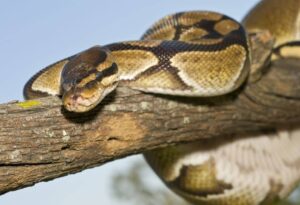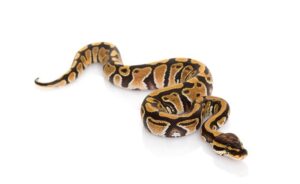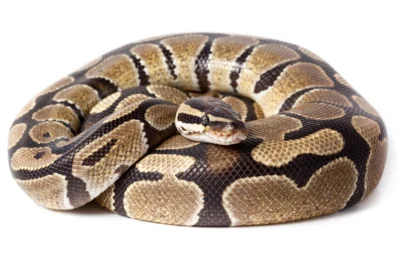Ball pythons, scientifically known as Python regius, are captivating reptiles that have become popular among reptile enthusiasts for their docile nature and striking patterns. As curious caretakers delve into the world of ball pythons, one question often arises: are ball pythons nocturnal?
Understanding the activity patterns of these mesmerizing creatures is crucial for providing them with optimal care and ensuring their well-being in captivity. In this exploration, we will delve into the fascinating behavior of ball pythons to uncover whether they are truly nocturnal and shed light on the intricacies of their daily rhythms.
Are ball pythons nocturnal?

Ball pythons (Python regius) are generally considered crepuscular rather than strictly nocturnal. Crepuscular animals are most active during the dawn and dusk periods, while nocturnal animals are active during the night. Ball pythons exhibit a behavior pattern where they are more active during the low-light conditions of early morning and late evening. During the day, they often seek shelter and rest.
In their natural habitat in sub-Saharan Africa, ball pythons may avoid the heat of the day by being more active during the cooler parts of the day. However, it’s essential to note that individual snakes may have variations in their behavior, and captive ball pythons may adapt to their environment and the routines of their keepers.
Providing a consistent day-night cycle with a proper light schedule can help maintain a healthy and natural behavior pattern for ball pythons in captivity.
Characteristics of Ball Pythons
Ball pythons (Python regius) are popular pet snakes known for their relatively docile nature, manageable size, and beautiful color variations. Here are some key characteristics of ball pythons:
- Size:
- Adult ball pythons typically range in length from 3 to 5 feet, although some individuals may grow slightly larger.
- Color and Pattern:
- Ball pythons are known for their striking patterns and color variations. Common morphs include albino, piebald, pastel, and many more, resulting in a wide array of colors and patterns.
- Body Structure:
- They have a sturdy and muscular body, with a relatively short and stout appearance. Their head is distinct from their neck, and they have heat-sensitive pits on their upper lip.
- Behavior:
- Ball pythons are generally known for their calm and docile nature. They are often considered good choices for first-time snake owners. When stressed or threatened, they may curl into a tight ball, covering their head with their coils, which is where their name “ball python” originates.
- Lifespan:
- With proper care, ball pythons can live for several decades. A well-maintained captive ball python can live 20 years or more.
- Habitat and Range:
- Native to sub-Saharan Africa, ball pythons are found in grasslands, savannas, and the edges of forests. They are known for spending much of their time in burrows or hiding places.
- Diet:
- In the wild, ball pythons primarily feed on small mammals such as rodents. In captivity, they are typically fed appropriately sized mice or rats. They are constrictors, meaning they subdue their prey by constriction before swallowing it whole.
- Reproduction:
- Ball pythons are known for their elaborate courtship and mating rituals. After mating, females lay eggs, and the female will coil around the clutch to protect them. Unlike some snake species, ball pythons do not incubate their eggs through body heat. Instead, they may coil around the eggs to protect them until they hatch.
- Habitat Requirements:
- Captive ball pythons need a secure enclosure with proper heating and lighting. A temperature gradient within the enclosure allows them to thermoregulate by moving between warmer and cooler areas. Substrate choices can include aspen shavings, cypress mulch, or coconut husk.
- Health Considerations:
- Proper humidity levels are crucial for shedding, as ball pythons shed their skin periodically. Respiratory infections can occur if humidity is too low. Regular veterinary check-ups and a proper diet are important for their overall health.
It’s important to note that individual ball pythons may have different temperaments and preferences, so it’s essential to monitor and understand the behavior of each snake in captivity. Providing a suitable environment and proper care are key factors in ensuring the well-being of ball pythons as pets.
Nocturnal Behavior in Ball Pythons

While ball pythons are not strictly nocturnal, they do exhibit crepuscular behavior, meaning they are most active during the dawn and dusk periods. In their natural habitat in sub-Saharan Africa, ball pythons tend to be more active during the cooler parts of the day, avoiding the heat of the midday sun. This behavior allows them to hunt and move about when temperatures are more favorable.
In captivity, ball pythons may also show increased activity during the evening and early morning. Some reasons for this behavior include:
- Temperature Regulation:
- Ball pythons are ectothermic, meaning they rely on external heat sources to regulate their body temperature. During the cooler periods of the day, they may actively seek out warmer spots in their enclosure to maintain optimal body temperature for digestion and other physiological processes.
- Hunting and Feeding:
- In the wild, ball pythons hunt for prey during the evening and early morning when many of their prey species are also active. In captivity, this behavior may persist, and some ball pythons may be more responsive to feeding during these times.
- Avoidance of Daytime Heat:
- In their natural habitat, ball pythons may retreat to burrows or shaded areas during the heat of the day to avoid excessive temperatures. In captivity, providing hiding spots and proper temperature gradients allows them to exhibit similar behavior.
- Crepuscular Nature:
- The crepuscular behavior of ball pythons is likely an adaptation that helps them balance the need for warmth and the avoidance of extreme temperatures. This behavior can also aid in avoiding predators and competing with other animals for resources.
It’s important for snake keepers to be mindful of their pet ball python’s natural behavior and provide an environment that allows for the expression of these behaviors. This includes providing a suitable day-night cycle, appropriate temperatures, hiding spots, and a consistent feeding schedule. Keeping these factors in mind contributes to the overall well-being and contentment of ball pythons in captivity.
Caring for Nocturnal Ball Pythons
Caring for ball pythons, which are crepuscular rather than strictly nocturnal, involves providing an environment that accommodates their natural behavior patterns.
Here are some essential aspects to consider when caring for ball pythons:
- Enclosure:
- Provide a secure and appropriately sized enclosure for your ball python. A well-ventilated glass or plastic terrarium with a secure lid is commonly used. Ensure that the enclosure has proper locks to prevent escapes.
- Substrate:
- Choose a suitable substrate for the enclosure. Aspen shavings, cypress mulch, or coconut husk are commonly used substrates. These substrates help maintain humidity levels and provide a comfortable surface for shedding.
- Temperature and Lighting:
- Maintain a proper temperature gradient within the enclosure. Ball pythons require a basking spot with temperatures ranging between 88-92°F (31-33°C) and a cooler side with temperatures around 75-80°F (24-27°C). Use under-tank heating pads or heat lamps to achieve these temperature ranges.
- While ball pythons are crepuscular, providing a consistent day-night cycle with a photoperiod of around 12 hours of light and 12 hours of darkness helps regulate their natural behavior.
- Hide Boxes:
- Offer hiding spots on both the warm and cool sides of the enclosure. Ball pythons appreciate having secure and snug hiding places where they can retreat for security and privacy.
- Humidity:
- Maintain appropriate humidity levels, especially during shedding periods. The humidity in the enclosure should be around 50-60%, but it can be increased to 70-80% when a snake is shedding to facilitate proper skin removal.
- Feeding:
- Ball pythons are constrictors and typically feed on appropriately sized mice or rats. Feed them in the evening or early morning, as this aligns with their crepuscular nature. Provide a consistent feeding schedule and monitor their body condition to ensure they are neither underweight nor overweight.
- Handling:
- Ball pythons are generally docile, but individual temperament can vary. Handle your snake gently and minimally, especially during the first few days after feeding. Avoid handling during shedding periods or if the snake is stressed.
- Health Monitoring:
- Regularly monitor your ball python for signs of good health, including clear eyes, healthy skin, and regular shedding. If you notice any changes in behavior, appetite, or appearance, consult with a veterinarian experienced in reptile care.
By understanding and accommodating the crepuscular nature of ball pythons, you can create a comfortable and enriching environment that promotes their well-being in captivity. Regular observation and proper care will contribute to a happy and healthy pet snake.
Challenges in Nocturnal Observation

Observing nocturnal animals, including crepuscular animals like ball pythons, can present several challenges due to the low light conditions during their most active periods. Here are some challenges and ways to overcome them:
- Low Light Conditions:
- Nocturnal observation is hindered by the limited availability of natural light. To overcome this, consider using artificial lighting sources such as infrared lamps or low-wattage reptile-specific bulbs. These lights can provide enough illumination without disrupting the natural behavior of the snake.
- Nocturnal Behavior:
- Nocturnal or crepuscular animals are most active during the night or dawn/dusk, making direct observation challenging. Use low-light cameras or night-vision equipment to monitor their behavior without disturbing them.
- Camouflage and Hiding:
- Ball pythons are skilled at hiding and may camouflage well within their enclosures. This makes it difficult to visually locate them. Providing adequate hiding spots and using accessories like branches or climbing structures can help them feel secure while also making them more visible.
- Limited Interaction:
- Nocturnal animals may not display their full range of behaviors during daylight hours. To address this, schedule some observations during their active periods, but also allow them quiet, undisturbed periods for natural behaviors.
- Temperature Variations:
- Some reptiles, including ball pythons, may exhibit more activity when temperatures are favorable. Ensure that the enclosure provides the proper temperature gradients, allowing the snake to choose the optimal temperature for its activity.
- Consistency in Observation:
- Establish a consistent observation routine that aligns with the snake’s natural activity cycle. This can help you gain insights into its behavior and habits over time.
- Use of Technology:
- Employ technology such as night-vision cameras or infrared thermometers to aid in observing and monitoring your ball python. This can provide a non-intrusive way to check on your snake without disrupting its natural behavior.
- Patience and Respect:
- Nocturnal observation requires patience and respect for the snake’s natural rhythms. Avoid excessive handling or disturbance during their resting periods, and observe from a distance whenever possible.
Remember that while observation is important for monitoring your ball python’s health and behavior, it’s equally crucial to provide a quiet and secure environment that allows the snake to express its natural behaviors without constant disturbance. Striking a balance between observation and providing a stress-free environment is key to the well-being of your pet snake.
Conclusion
This page answers the question are ball pythons nocturnal. While ball pythons are not strictly nocturnal, they exhibit crepuscular behavior, being most active during dawn and dusk. This behavior, known as crepuscularity, allows them to regulate body temperature, hunt, and engage in other activities during the cooler parts of the day.
Understanding and accommodating their crepuscular nature is crucial for providing proper care and creating a suitable environment for ball pythons in captivity.

